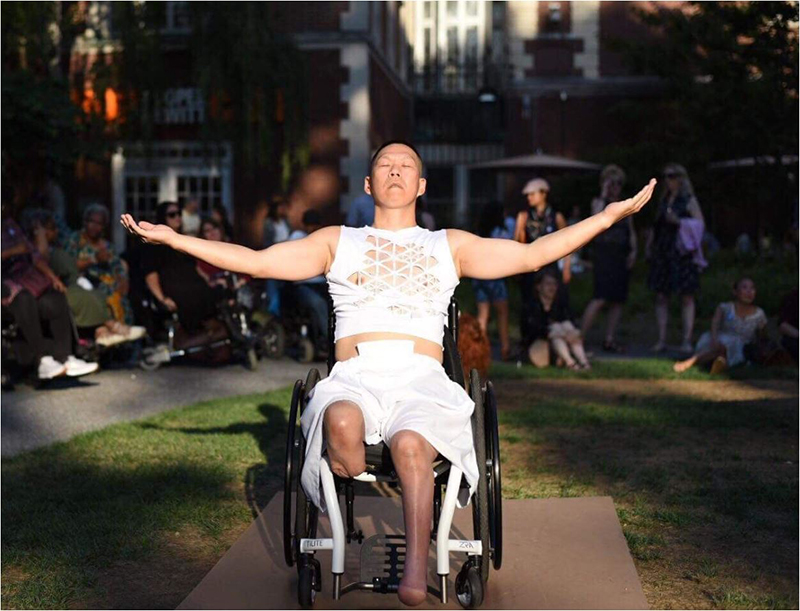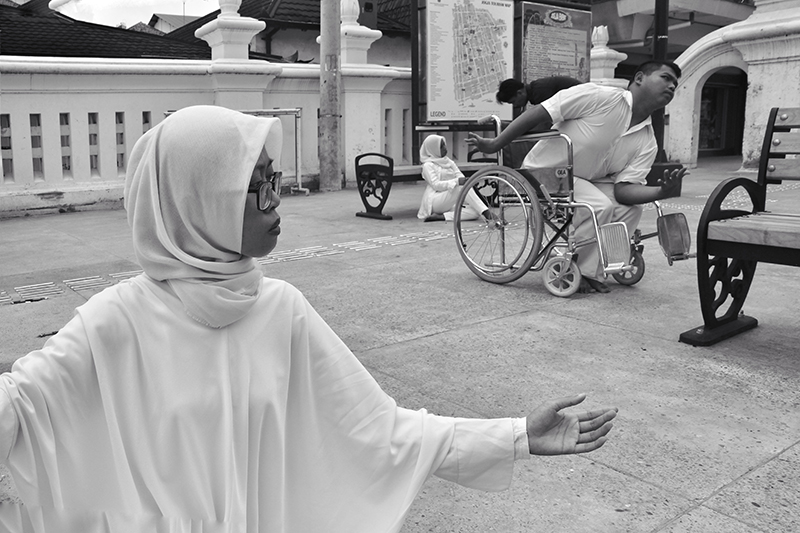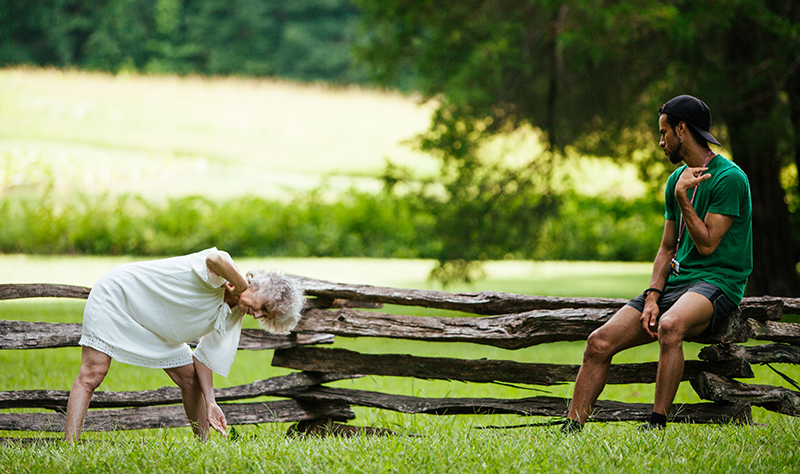On Virtual Display
An Interview with Heidi Latsky
BY EMMALY WIEDERHOLT
Heidi Latsky is the artistic director of Heidi Latsky Dance, a performance company in New York City. Since 2015, her company has been producing ON DISPLAY, a human sculpture court exposing the body and inviting the gaze. The piece is now produced in cities around the globe every December 3rd in honor of International Day of Persons with Disabilities. This year, because of the pandemic, Heidi Latsky Dance is pivoting to a virtual performance on Zoom. Here, Heidi shares how the event will work, as well as how she’s shifting toward film more generally.

ON DISPLAY at the Cooper Hewitt Smithsonian Design Museum in NYC, Photo by Bhagirath Iyer
~~
Can you briefly describe what On Display is for people unfamiliar with it?
In 2015, the Mayor’s Office for People with Disabilities in New York City invited my company to do guerilla art throughout the city and the boroughs during the month of July to expose the public to people with disabilities. I wanted to do something integrated since that’s what my company does. That’s when ON DISPLAY started.
It’s simply a sculpture court or sculpture garden where all the sculptures are people. Each cast is ideally very diverse in every way, not just in terms of disability, but also race, age, body type, and gender. And the cast is very still. The sculptures don’t really move; they morph. Their eyes are open in stillness and they are still 98 percent of the time, until they morph when they close their eyes. ON DISPLAY happens in public spaces so, as people walk through, they have time to really look. There’s this whole conversation in disability about the gaze. But the performers here have agency to look or not look. If I’m a sculpture, I don’t have to look back at whoever is looking at me, but I can.
After we did ON DISPLAY all over New York City, I wanted to find a day when other people around the world could join us. I learned from a friend in Australia that the UN made December 3rd International Day of Persons with Disabilities. So on December 3rd, 2015, I managed to get my company into the UN, and we simulcast with a dance company in Hobart, Australia. That’s when ON DISPLAY GLOBAL started. From two sites in 2015, we’re up to almost 100 now, and we’re all over the world.
How will ON DISPLAY GLOBAL be presented this year in light of the pandemic?
So what do you do during COVID? In a beautiful way, ON DISPLAY GLOBAL is the perfect antidote to this pandemic because it brings communities together all over the world. For the 30th anniversary of the Americans with Disabilities Act this past summer, my company did a 35-person virtual ON DISPLAY on Zoom, which was quite beautiful. Everyone was muted, whether you were the audience or a sculpture. That is basically what we’re going to do on a larger scale on December 3rd this year.
The sites are in different countries and cities. Depending on social distancing rules, some people are able to be outside and come together, so those communities might do it live like in the past and also join the Zoom call. The idea right now is that we’ll take the entire day (12 AM to 12AM EST), and we’ll organize different cities to join depending on their time zone. We’re going to encourage people to stay for as long as they want. It’s really a feat of endurance. People will come on according to time zone and then leave whenever they’re done.

ON DISPLAY GLOBAL in Auckland, New Zealand, Photo by Thian Benton Fieulaine
How will audiences access the virtual performance?
They’ll come to the same Zoom link as the performers. There will be a waiting room for everyone, and then they’ll be let in. If you can imagine all these Zoom boxes – let’s say there are 20 on a page – there will be sculptures and audience members hodgepodge. That’s what ON DISPLAY is; the public goes into the sculpture court. The performers wear white, so you can usually tell who they are, but sometimes it’s hard to tell who is in it and who is watching. It has amazed me over the years how many audience members will become a sculpture and it is something we will encourage this year.
We just solidified a partnership with Disability Unite Festival and Art Beyond Sight. I think they’re going to stream the event live for us. NYU Tisch is our main partner and they will be providing the Zoom space as well as helping us staff the 24-hour event. We’ve never done this before, so we have to think about how we get people to watch. Of course, we’ll also send out publicity, but we want to encourage everyone who’s going to participate to invite their friends, family, whomever.
How can those interested get involved?
Anyone can join, but they must learn the score first. It’s a specific structured improvisation, but you don’t need any performance or dance experience. It’s a lot of stillness. If an individual was interested in joining us, they’d just have to contact us and we’d either put them in a group or teach them individually so when they come on the Zoom call, they really know what they’re doing. It doesn’t take that long to learn.
In the past, we’ve had partners in different cities, who we call our ambassadors. They would produce the event in their city, and we would send them a packet and instructions. These ambassadors can help get their local communities involved this year as well.
How many people are you expecting to participate?
We have around 100 ambassadors, and in past years each site has varied in number of participants from a trio to 35 or more people. I think the number of people on this year’s Zoom performance will be in the hundreds, and I’m hoping by the end of the day there will be thousands.
What’s the last date that ambassadors or individuals can sign up to participate?
I would say a week before, which is late in the game, but people can’t join last minute unless they’ve done ON DISPLAY before.
When ON DISPLAY works is when everyone is internally focused. No one is performing. It’s important that the people in it understand they’re not dancing. The morphing is a slight move. It’s a journey of discovery, where you move so subtly, the audience is not sure you’ve moved at all.

ON DISPLAY GLOBAL in Yogyakarta, Indonesia, Photo by Yoana Wida
I understand there’s a fashion element to ON DISPLAY. How will that play out virtually?
The fashion element has mostly been for my company. In ON DISPLAY at Lincoln Center in 2015, I hired a fashion designer. In thinking about the gaze, your typical famous model or actor is as much on display as someone with a disability. I wanted to make a statement that the piece is not just about disability, but could be about someone unusually tall or short, or even classically stunning. The designer made this gorgeous clothing that kind of looked like hospital gowns with plastic windows.
Then in 2016 we started partnering with NuVu Studios, a residency program that works with middle and high school students. Over the years, the students have created 3D-printed wearable art pieces for each dancer they interview. I am thrilled because these young kids who probably have never met someone with a disability get to interview someone with a disability and then make them a garment. It has been a really successful partnership. But again, this has all been for my company.
With ON DISPLAY GLOBAL, I question whether we should wear the wearable art and fashion. I think in New Zealand, one of the sites hired a costume designer. Sites can do that if they follow the guidelines. But the idea is that everyone is wearing the simplest of whites. In the past few years, certain people have worn the wearable art. I still haven’t made the decision if my dancers will use the wearable art, polka dotting the rest of the participants on the Zoom call who will just be in white.
Speaking more generally, how has Heidi Latsky Dance responded to the pandemic?
I don’t think I’m worse off than anyone else, but the reality is we have no work. I have some teaching work, but ON DISPLAY GLOBAL is purely volunteer. I pay someone to run it because it’s almost a fulltime job, but we make no money from it. We’re committed to seeing it through, but the reality is the company is not in rehearsal. We’ve been talking to presenters and venues to try to understand their trajectory. One thing I have done is expanded our education wing. We’re working with young audiences so we can still be vital.
I’m making three volumetric videos right now with two disabled women and me. The goal is for those to go into museums. We’re also creating two-dimensional representations so perhaps a museum could use that if they are afraid to give people goggles. I was commissioned by Lincoln Center to make a piece for the 30th anniversary of the ADA, so I made a film called Solo Flight. Now I’m in the process of making 10 Solo Flight films, like a series. All my dancers are sending me material from their houses. I’m also working with someone at Google making an interactive and virtual piece that is spectacular. I have also collaborated this summer with two developers to create a 360-degree short film about ON DISPLAY GLOBAL, and it’s almost finished.
I’m shifting to virtual, which is very exciting and relatively new for me. Now it’s a question of if I can monetize what I’m creating and how long we can sustain our company. My dancers aren’t working right now for the most part. How long can we keep going with this uncertainty?
Do you see dance continuing to present in digital spaces after the pandemic? How does Zoom change accessibility?
I’m not a big fan of dance on camera. I made a dance film in 2015 called Soliloquy, but in general I’m not interested in watching choreography on film as much as using dance to create film. I think more people like me will get into virtual spaces and get creative with it.
I don’t think people are running back to the theaters. It’s either going to go one way or another; we’ll get burnt out and we’ll flock to the theaters, or my prediction is that Zoom will become a tool we continue to use even when spaces reopen.
My company hosts community conversations every week on Zoom, and people from all over the country join us now. And I can see them on video, so it’s really not so bad. For convenings and accessibility, it’s great. Unfortunately, some of my dancers don’t have internet access at home. That’s where you see the big divide. I was telling someone at Dance/NYC that I’m such a homebody that I’m actually loving being at home, and she responded, “That’s probably because you have a nice apartment. Think about the people who don’t have a comfortable place to live.” It was a moment of reckoning for me.
I feel privileged and grateful for what I do have and for my health so far, and the pandemic is allowing me the opportunity to explore the medium of film more. I think some people are going to come out of this with a different set of skills.
Any other thoughts?
The beauty of ON DISPLAY for a performer is it’s an opportunity to just drop into your body without worrying about the audience at all. It’s challenging and meditative at the same time. A testimony to the experience is that mostly all the people who started ON DISPLAY with me in 2015 are still doing it. Heidi Latsky Dance alone has done more than 100 installations. I would encourage performers and non-performers alike to join us and have that experience.

ON DISPLAY at the American Dance Festival in Durham, NC
~~
To learn more about Heidi Latsky Dance, visit heidilatskydance.org.
To learn more about ON DISPLAY GLOBAL this year, visit ondisplay.us/global.
